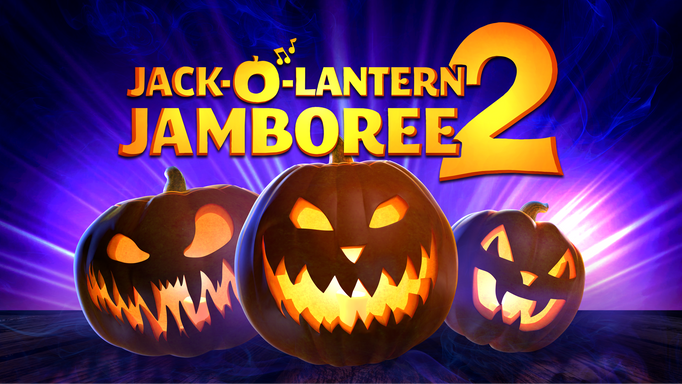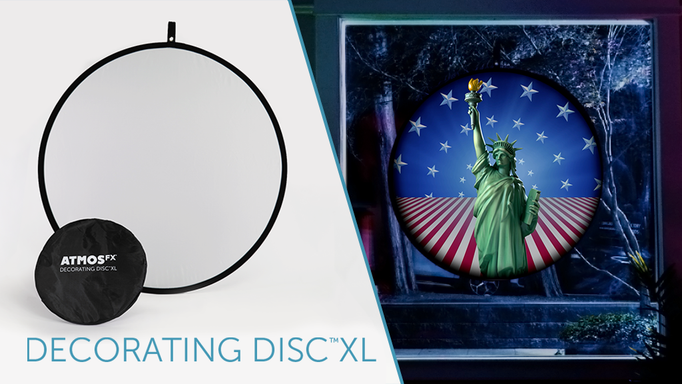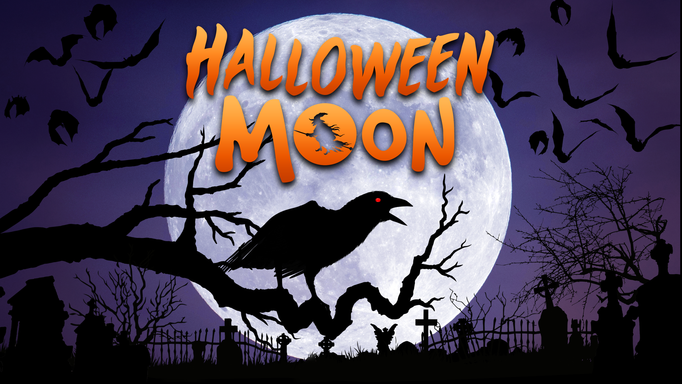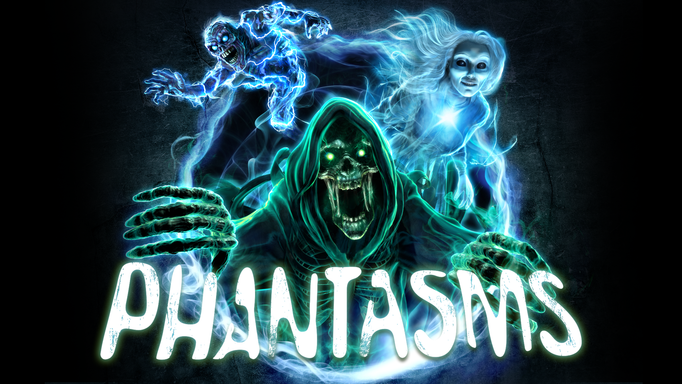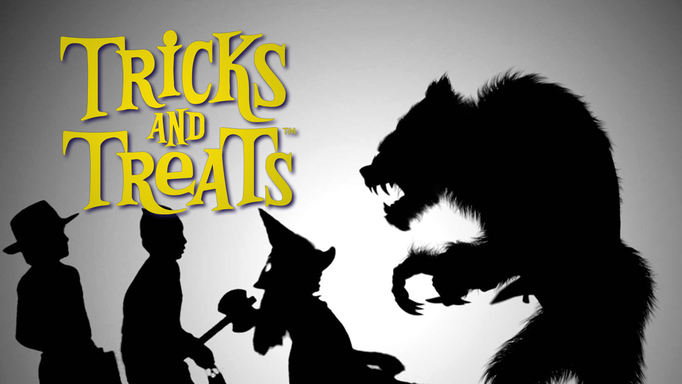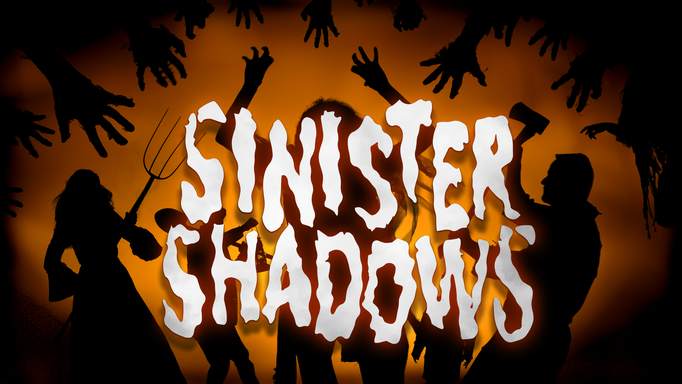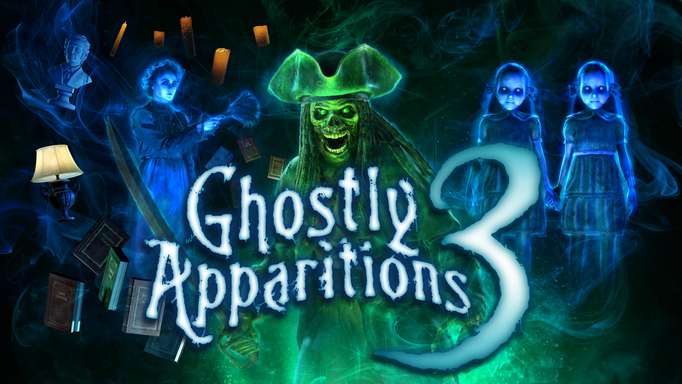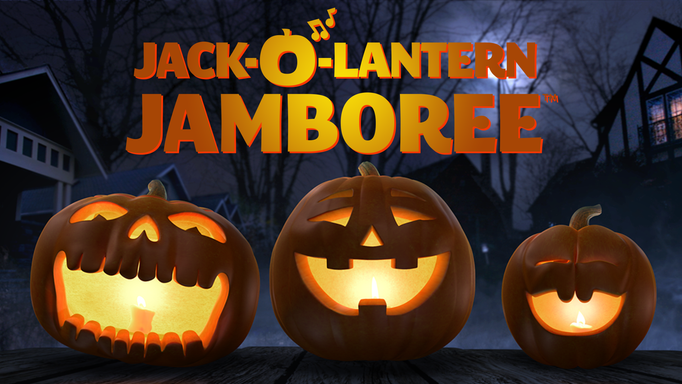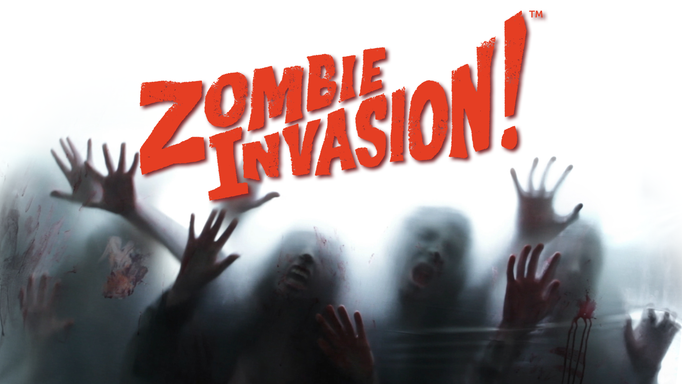“What projector do you recommend?” It’s one of the most common questions we get asked, and for good reason – there’s a lot to consider when shopping for a new projector. Don’t worry – we’ve got you covered! In this post, we’ll get you up to speed on projector basics, explain some of the key features all projectors have, and give you some tips that will help you find the perfect projector for your decorating needs.
So, let’s begin.

The pumpkin trio from Jack-O’-Lantern Jamboree 2 projected onto real pumpkins.
Understanding projectors
Projectors are like any tech gadget: the more features and more power they offer, the more expensive they can be. Every year the projector market continues to grow, so it’s easier than ever to find a projector that’s perfect for your decorating needs.
The trick to finding a great projector is to first think about how (and where) you’ll use it. Will you be projecting AtmosFX Decorations from across your lawn onto the side of your house, or are you going to decorate your living room wall for a party? Will you be using your projector in a dark room, or are you going to have it set up in a room with the lights on? Once you have an idea in mind, you’ll be able to more easily figure out what features your projector will need to have to bring your vision to life.

Project easily onto the AtmosFX Decorating Disc XL with decorations like Halloween Moon, shown here.
Have that idea ready? Great! Let’s run though some of the most important features all projectors have. We’ll explain a bit about what each one means and tell you how it’s going to apply to different decorating situations.
Lumens
The light output of a projector is measured in units called “lumens.” Lumens are meant to measure the brightness of a projector, so that the higher the number, the brighter the projector will be. However, because lumens can be measured in many different ways, directly comparing these numbers is not always accurate.
For example, many budget projector brands will use a “marketing lumens” measurement, based on an unscientific estimate of brightness. Sometimes, you will see something called ANSI lumens. This is a unit defined by the American National Standards Institute (ANSI), that measures the overall amount of light output by a projector and usually requires the projector be officially tested to use this rating.
Lumens ratings on budget projectors can sometimes be listed as high as 5000-8000 lumens – which is a lot! Unfortunately even when comparing these numbers between projectors, these numbers may be artificially inflated. It is wise to be skeptical if a really high lumen count comes with a really low price. Claims that sound too good to be true usually are.
For comparison, the AtmosKIT Plus Halloween, AtmosKIT Plus All-Season, and the AtmosKIT Plus Christmas include a ViewSonic M1+ projector with a 300 LED lumens count. LED lumens are a more accurate measurement because of the LED light source. Despite the numbers being so different from the typical “marketing” lumens measurement, the projector can be as bright or often brighter than budget projectors that claim to have 5000-8000 lumens.

The portable ViewSonic M1+ projector that comes in the AtmosKIT Plus Halloween, AtmosKIT Plus All-Season, and the AtmosKIT Plus Christmas is a 300 LED lumens projector.
So why does a higher lumen count matter? It can help ensure the detail of your projection will be seen, especially when projecting images across long distances or when there’s competing ambient light. Essentially, it gives you more versatility; you’ll be able to use your projector in a variety of locations, light or dark, and successfully project onto both large or small areas.
That said, we recommend thinking about where and how you want to decorate – that will be the best indicator of how bright a projector you may need. For example, if you want to make it seem like Phantasm’s ‘Demonic Poltergeist’ is bursting through your garage door, you’ll probably want a projector with a higher lumen count – you’ll need some extra muscle to project on a large space with a lot of ambient light. However, if you want to project a shadow scene from Tricks and Treats or Sinister Shadows in your window, a lower lumen count will be fine. Shadows are less detailed, so fewer lumens are needed.
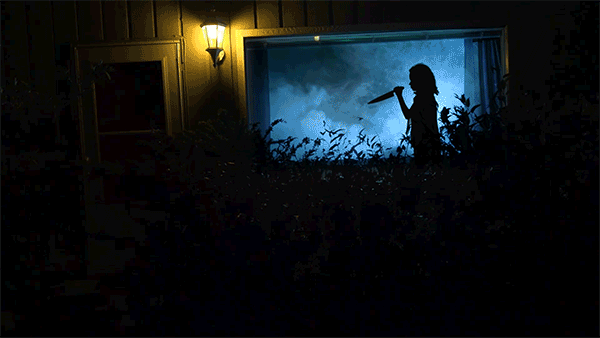
Sinister Shadow’s scary creatures come to life when projected onto a window.
Display resolution
With the incredible rise in popularity of HD video, lots of people are interested in getting a projector with the highest resolution possible. But what is display resolution, anyway?
Display resolution measures the number of pixels available on any screen or projector. The resolution is measured both horizontally and vertically, but they are usually represented by a single number which counts the vertical pixels. For example, a 1080 HD resolution features 1920 horizontal pixels by 1080 vertical pixels. Multiply those numbers together, and the resolution can display over 2 million pixels.
When you’re projector shopping, most projectors will boast a 1080p or 4K HD experience. Buyer beware: This is often a misleading tactic from less trustworthy sellers to hide their actual display resolution. In reality, most budget projectors are merely stating they can play video files of 1080 or 4K quality, even though the actual projector’s resolution is much, much lower. It’s always important to check a projector’s “Native Resolution” to find the actual resolution. You’ll quickly find that most budget projectors are actually at or below Standard Definition (SD), even though they may claim to be HD.
High-Definition resolution can make a big difference when projecting AtmosFX Decorations with lots of detail, such as one of our vibrantly detailed decorations like Ghostly Apparitions 3 or Legends of Halloween. If your decoration features a full color background, or if you are planning to project your decoration on a massive scale, then HD may be worth the investment.

A haunted window, featuring the Materializing Maid from Ghostly Apparitions 3.
However, HD resolution isn’t required to create dazzling decorations. Resolution is just one of many factors that can contribute to a cool decoration. You can get stunning results from a Standard Definition projector like the ViewSonic M1+ included in the AtmosFX projector kits. If your projector is below standard definition you can try decorations with less detail, like the silhouette decorations from Sinister Shadows, or the talking pumpkin faces from and of the three Jack-O’-Lantern Jamboree decorations. Because there is less detail, these decorations can look great on a wider range of projectors.
Throw distance
Another term that you may run into when projector shopping is “throw distance.” This is very important for home decorators, who may have a very specific idea of where to set up their projector.
Throw distance is almost always measured as a ratio that compares the amount of space between the projector and projection surface to the width of the final projected image. Simply put, this measurement will tell you exactly how close the projector needs to be to its screen to achieve your desired ideal size.
For example, the ViewSonic M1+ and ViewSonicM1 Mini Plus have a 1.2:1 throw ratio. For every 1.2 feet of distance between the projector and the screen, you'll see a projected image that is 1 foot wide. That means the throw ratio can tell you how far away to place your projector. Once you know this, you’ll know if the projector you’re looking at will work for your needs or whether you need to consider a different model.

Depending on their throw ratio, projectors are usually categorized as “long throw,” “short-throw,” or even “ultra-short throw.” A long throw projector will perform better farther away from its screen, so if you want to project zombies on the exterior of your house from 30 feet away with good resolution, this will be a good projector choice for you. Conversely, a short throw projector will do better closer to its screen because it creates a larger image in a shorter distance. So, if you’re looking to decorate an inside wall and you only have three to four feet to work with, a short throw projector will work best for your needs.

The ViewSonic M1+ projector can display an image 7 feet wide from 8.5 feet away.
Projector connectivity
While lumen count, resolution, and throw distance are the three biggest things to consider when purchasing a projector for decorating, don’t forget to pay attention to the types of connections it supports – especially when it comes to video and audio. If high-definition is important to you, make sure your projector has an HDMI (High-Definition Multimedia Interface) port. This will ensure you can project both audio and video in high-definition. If you plan to hook up external speakers to crank up your decoration’s sound effects, make sure the model you’re considering has some way to output audio.

Here are the outputs from the M1+ projector in the AtmosKIT Plus Halloween, AtmosKIT Plus All-Season, and the AtmosKIT Plus Christmas as an example of what to look for.
If you do happen to buy (or already own) a projector that doesn’t have the connections that you need to hook up a specific device, keep in mind that there are many adapters that may allow you to connect an external video player using the inputs you already have. A quick online search for something like “HDMI adapter,” along with the input your projector uses, may save you both time and money later.

Using a projector to display “Plaster Disaster” from Zombie Invasion! on your wall will send your guests screaming.
So, what should you buy?
By now, you should be well on your way to buying your new projector! Every decorating situation is different, so it’s time to take the information we’ve given you and use it as a guide to picking your perfect projector. Remember that different projectors are great for different things, so (and we can’t stress this enough), think about how you’ll be using yours, and base your final decision on your personal needs. Sometimes a simple projector with fewer bells and whistles is precisely what you need.
Still have questions? Don’t be afraid to ask advice from your fellow AtmosFANs in the AtmosFX Decorating Community on Facebook. Many people have been creating amazing digital environments for years, and have plenty of suggestions about what projectors have worked well for them.
If you happen to be one of our veteran projectionists, we’d love to get your thoughts on what makes a great projector! Drop a comment and let us know what you think. You may end up helping someone along the way.
---
Come back here often – we’ll be posting more articles on how to best use your AtmosFX Decorations throughout the Halloween season. And don’t forget to check our support pages – there are numerous projector-related questions (and answers!) there, too.

